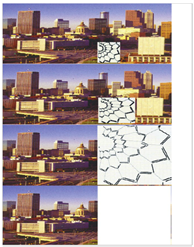Question: What 3 historical factors can help establish that a transient loss of vision reported to be unilateral by the patient is consistent with the visual aura of migraine?
 1
1
____________________________________________________
Answer: The 3 historical factors that can help establish that a transient loss of vision reported to be unilateral by the patient is consistent with the visual aura of migraine are:
1. The vision and visual fields return to normal after the aura, usually within 20 to 30 minutes (always less than 1 hour).
2. The progressive buildup of symptoms (“migrainous march” – the scotoma enlarges over several minutes, and then gradually disappears).
3. The richness of visual phenomena (typically a small scotoma in homonymous portions of the visual field, surrounded by jagged, luminous, shimmering edges).
Explanation:
“Pearls
Although migrainous visual aura is binocular by definition (since it originates from the occipital lobe), many patients do not recognize the visual phenomena as being in both eyes, especially when they involve only one hemifield. The relatively long duration of visual phenomena, the progressive buildup of symptoms (“migrainous march”), and the richness of visual phenomena strongly suggest migrainous visual auras, even when the patient thinks the visual symptoms were only in one eye.
Migrainous Visual Aura

Fig.6.1 Progression of visual changes during migrainous visual aura (from top to bottom)
Visual aura associated with migraine is the most common cause of transient binocular visual loss (▶Fig. 6.1). The patient typically notes a small scotoma in homonymous portions of the visual field, surrounded by jagged, luminous, shimmering edges. The scotoma enlarges over several minutes, then gradually disappears. The visual loss may enlarge to a complete homonymous hemianopia. A hemicranial throbbing headache characteristically follows (see Chapter 19). Some patients experience the visual aura of migraine without associated headache. The vision and visual fields return to normal after the aura, usually within 20 to 30 minutes (always less than 1 hour).”1
Reference: 1. Neuro-ophthalmology Illustrated-2nd Edition. Biousse V and Newman NJ. 2012. Theme
More than 600 additional neuro-ophthalmology questions are freely available at http://EyeQuiz.com.
Questions prior to September 2016 are archived at http://ophthalmology.stanford.edu/blog/
After that, questions are archived at https://neuro-ophthalmology.stanford.edu
Follow https://twitter.com/NeuroOphthQandA to be notified of new neuro-ophthalmology questions of the week.
Please send feedback, questions and corrections to tcooper@stanford.edu.